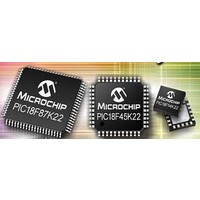PIC18F46K22-I/MV Microchip Technology, PIC18F46K22-I/MV Datasheet - Page 163

PIC18F46K22-I/MV
Manufacturer Part Number
PIC18F46K22-I/MV
Description
64KB, Flash, 3968bytes-RAM,8-bit Family,nanoWatt XLP 40 UQFN 5x5x0.5mm TUBE
Manufacturer
Microchip Technology
Series
PIC® XLP™ 18Fr
Datasheet
1.PIC18F26J13-ISS.pdf
(496 pages)
Specifications of PIC18F46K22-I/MV
Core Processor
PIC
Core Size
8-Bit
Speed
64MHz
Connectivity
I²C, SPI, UART/USART
Peripherals
Brown-out Detect/Reset, HLVD, POR, PWM, WDT
Number Of I /o
35
Program Memory Size
64KB (32K x 16)
Program Memory Type
FLASH
Eeprom Size
1K x 8
Ram Size
3.8K x 8
Voltage - Supply (vcc/vdd)
1.8 V ~ 5.5 V
Data Converters
A/D 30x10b
Oscillator Type
Internal
Operating Temperature
-40°C ~ 85°C
Package / Case
40-UFQFN Exposed Pad
Processor Series
PIC18F
Core
PIC
Data Bus Width
8 bit
Data Ram Size
4 KB
Number Of Programmable I/os
36
Number Of Timers
3 x 8-bit. 4 x 16-bit
Operating Supply Voltage
1.8 V to 5.5 V
Mounting Style
SMD/SMT
Lead Free Status / RoHS Status
Lead free / RoHS Compliant
Lead Free Status / RoHS Status
Lead free / RoHS Compliant
- Current page: 163 of 496
- Download datasheet (5Mb)
12.3
Timer1/3/5 has four prescaler options allowing 1, 2, 4 or
8 divisions of the clock input. The TxCKPS bits of the
TxCON register control the prescale counter. The
prescale counter is not directly readable or writable;
however, the prescaler counter is cleared upon a write to
TMRxH or TMRxL.
12.4
A
oscillator circuit is built-in between pins SOSCI (input)
and SOSCO (amplifier output). This internal circuit is to
be used in conjunction with an external 32.768 kHz
crystal.
The oscillator circuit is enabled by setting the
TxSOSCEN bit of the TxCON register, the SOSCGO bit
of the OSCCON2 register or by selecting the
secondary oscillator as the system clock by setting
SCS<1:0> = 01 in the OSCCON register. The oscillator
will continue to run during Sleep.
12.5
If control bit TxSYNC of the TxCON register is set, the
external clock input is not synchronized. The timer
increments asynchronously to the internal phase
clocks. If external clock source is selected then the
timer will continue to run during Sleep and can
generate an interrupt on overflow, which will wake-up
the processor. However, special precautions in
software are needed to read/write the timer (see
Section 12.5.1 “Reading and Writing Timer1/3/5 in
Asynchronous Counter
2010 Microchip Technology Inc.
Note:
Note:
dedicated
Timer1/3/5 Prescaler
Secondary Oscillator
Timer1/3/5 Operation in
Asynchronous Counter Mode
The oscillator requires a start-up and
stabilization time before use. Thus,
TxSOSCEN should be set and a suitable
delay
Timer1/3/5.
When switching from synchronous to
asynchronous operation, it is possible to
skip an increment. When switching from
asynchronous to synchronous operation,
it is possible to produce an additional
increment.
secondary
observed
Mode”).
low-power
prior
to
32.768 kHz
enabling
Preliminary
12.5.1
Reading TMRxH or TMRxL while the timer is running
from an external asynchronous clock will ensure a valid
read (taken care of in hardware). However, the user
should keep in mind that reading the 16-bit timer in two
8-bit values itself, poses certain problems, since the
timer may overflow between the reads. For writes, it is
recommended that the user simply stop the timer and
write the desired values. A write contention may occur
by writing to the timer registers, while the register is
incrementing. This may produce an unpredictable
value in the TMRxH:TMRxL register pair.
12.6
Timer1/3/5 can be configured to read and write all 16
bits of data, to and from, the 8-bit TMRxL and TMRxH
registers, simultaneously. The 16-bit read and write
operations are enabled by setting the RD16 bit of the
TxCON register.
To accomplish this function, the TMRxH register value
is mapped to a buffer register called the TMRxH buffer
register. While in 16-Bit mode, the TMRxH register is
not directly readable or writable and all read and write
operations take place through the use of this TMRxH
buffer register.
When a read from the TMRxL register is requested, the
value of the TMRxH register is simultaneously loaded
into the TMRxH buffer register. When a read from the
TMRxH register is requested, the value is provided
from the TMRxH buffer register instead. This provides
the user with the ability to accurately read all 16 bits of
the Timer1/3/5 value from a single instance in time.
In contrast, when not in 16-Bit mode, the user must
read each register separately and determine if the
values have become invalid due to a rollover that may
have occurred between the read operations.
When a write request of the TMRxL register is
requested, the TMRxH buffer register is simultaneously
updated with the contents of the TMRxH register. The
value of TMRxH must be preloaded into the TMRxH
buffer register prior to the write request for the TMRxL
register. This provides the user with the ability to write
all 16 bits to the TMRxL:TMRxH register pair at the
same time.
Any requests to write to the TMRxH directly does not
clear the Timer1/3/5 prescaler value. The prescaler
value is only cleared through write requests to the
TMRxL register.
PIC18(L)F2X/4XK22
Timer1/3/5 16-Bit Read/Write Mode
READING AND WRITING
TIMER1/3/5 IN ASYNCHRONOUS
COUNTER MODE
DS41412D-page 163
Related parts for PIC18F46K22-I/MV
Image
Part Number
Description
Manufacturer
Datasheet
Request
R

Part Number:
Description:
Manufacturer:
Microchip Technology Inc.
Datasheet:

Part Number:
Description:
Manufacturer:
Microchip Technology Inc.
Datasheet:

Part Number:
Description:
Manufacturer:
Microchip Technology Inc.
Datasheet:

Part Number:
Description:
Manufacturer:
Microchip Technology Inc.
Datasheet:

Part Number:
Description:
Manufacturer:
Microchip Technology Inc.
Datasheet:

Part Number:
Description:
Manufacturer:
Microchip Technology Inc.
Datasheet:

Part Number:
Description:
Manufacturer:
Microchip Technology Inc.
Datasheet:

Part Number:
Description:
Manufacturer:
Microchip Technology Inc.
Datasheet:










